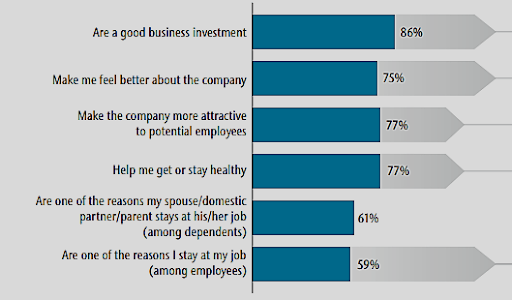
What if your employees had the means to make corporate health and wellness an integral part of their workday? How might that impact your people’s engagement levels? How about your company’s productivity and its ability to attract and retain talent? Ultimately, how would it affect the bottom line?
But wellness is more than a program. Instead, think of it as a way to improve your quality of life and help your people show up as their best selves every day. And believe me, health matters in your business setting.

Consider these employee responses to an Aon Hewitt survey that asked for their opinions on workplace wellness initiatives offered by employers:
Yes, wellness programs matter. Here are some more reasons why:
- Your company foots the bill for unhealthy employees.
- Building a healthy workforce provides many benefits beyond ROI.
Let’s jump in…
The Onerous Costs of “Sick-Care”
Health insurance and claims costs are soaring exponentially. You are trying to minimize cost increases while remaining competitive for marketplace talent. But your foundational strategies are not keeping up with the realities of an unhealthy workforce. A reactive care model is just not sustainable.
Our country’s healthcare system wasn’t designed to help prevent the onset of disease but rather to diagnose and treat illness. Hence, the American healthcare system, and the fallback position of many companies, is based on an acute care model, where the focus is to address (instead of prevent) urgent issues and manage chronic diseases. This reactive approach is expensive and inefficient. It’s why more and more companies are embracing a new model that promotes proactive health and wellness.
According to the Centers for Disease Control and Prevention (CDC), preventable chronic conditions are at an all-time high in the US. They are also a major contributor to the costs of employee medical claims and health insurance premiums. The CDC lists five chronic conditions or risk factors:
- High blood pressure
- Diabetes
- Smoking
- Physical inactivity
- Obesity
These cost US employers a whopping $36.4 billion a year because of employees missing days of work. Obesity alone increases job absenteeism due to injury or sickness by three days per year. And post-pandemic, obesity has risen. Annually, productivity losses due to obesity range from $271 to $542 for each obese employee. When calculating the cost-effectiveness of interventions, it’s vital to take reductions in absenteeism into account.
Research shows that employees of normal weight cost $3,830 per year on average for a covered medical, sick day, short-term disability, and worker’s comp claims combined. Employees that were morbidly obese cost over double that amount, or $8,067 – and that was in 2011!
In all, US employers spent an estimated $13,728 per employee on healthcare in 2020, and this spending will only continue to rise. The Centers for Medicare and Medicaid Services projects that national health costs will increase at an average annual rate of 5.4% until 2028.
Your company may have little control over many of the factors that drive up healthcare costs, but one area you can influence is the incidence of your employees’ unhealthy habits. Because here’s the thing, all the above risk factors can be controlled – and often prevented – with proven, achievable lifestyle changes. Yes, getting your employees to move more, eat healthily, reduce stress, sleep better, and work on detrimental habits can pay huge dividends.
In fact, supermarket chain H-E-B found that over time, moving just 10 percent of employees from high and medium-risk to low-risk status yielded an ROI of 6 to 1! But investing in workplace well-being has tangible benefits beyond monetary savings. Let’s explore…
Going beyond ROI
Here are just a few of the additional benefits of providing a wellness program for your workforce:
More likely to stay, more likely to recommend
Providing corporate wellness services is an investment in attracting and retaining talent. Research shows that the availability of well-designed wellness programs improves employees’ net promoter score (eNPS). Employees with access to 7-8 programs are one and a half times more likely to remain with their employer. 89% of workers at companies that provide wellness initiatives are more likely to recommend their company as a good place to work. Programs that help employees manage chronic conditions and provide a physical work environment that promotes healthy decision-making have the biggest impact on eNPS. And ultimately, attracting and retaining talent reduces the burden of an already busy HR staff.
Increased productivity
Companies that promote well-being can experience 21% higher productivity. And compromised employee health is one of the top reasons for lagging productivity. The last thing your company needs is a sluggish and mediocre workforce. Taking part in company wellness programs involves developing healthy habits, such as regular exercise, stress reduction, improved sleep hygiene, and good nutrition, that are linked to more productive behaviors. Better health results in a more focused and motivated workforce.
For instance, one Harvard study demonstrated that the benefits of exercise go beyond physical. Evidence suggests that it boosts mental abilities like:
- Improved cognitive function
- Sharper memory
- Enhanced creativity
- Better concentration
Employees that exercise regularly are for the most part healthier than their sedentary co-workers. This results in fewer sick days and medical appointments, and overall reduced absenteeism.
Better nutrition also matters. One Brigham Young study of nearly 20,000 employees found that those with unhealthy diets were 66% more likely to report lower productivity. But employees who eat right get more done in a day.
As Virgin’s Richard Branson advises corporate leaders, “Take care of your employees and they will take care of your business. It’s as simple as that. Healthy, engaged employees are your top competitive advantage.”
Bottom line: better habits lead to better health and better outcomes. So, what positive outcomes might your company gain by implementing a comprehensive corporate wellness solution?

